Alex Cheong Pui Yin
16th March 2022 - 20 min read
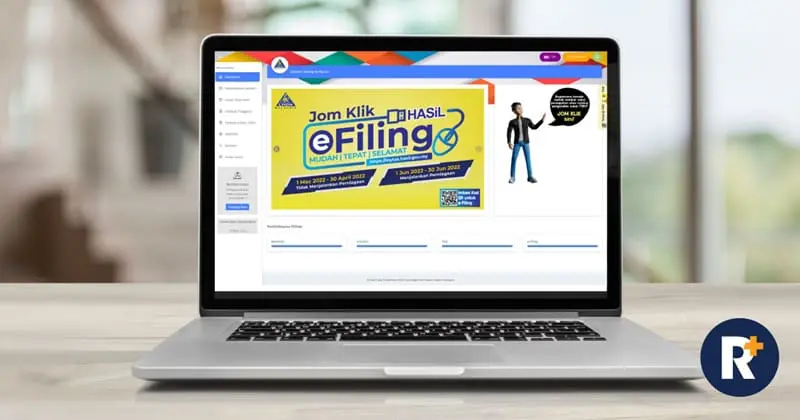
NOTE: This is the income tax guide for the year of assessment 2021. If you are filing your taxes in 2023, then head on over to our income tax guide for YA 2022 here.
March has arrived, and we all know what that means: time to file your taxes. But are you prepared to tackle the task? Do you have your EA forms ready? Have you determined your income tax rates, and collected all the receipts for your tax reliefs? For that matter, what are the tax reliefs that you’re entitled to? And where should you start if you’re a first-time taxpayer?
Many Malaysians may find the tax filing process a little…well, taxing – but we’re here to help! Here’s our complete guide to filing your income taxes in Malaysia 2022, for the year of assessment (YA) 2021.
Do You Need To Pay Income Tax?

If you’re an individual earning more than RM34,000 per annum (about RM2,833.33 per month) after EPF deductions, you have to register a tax file.
Income tax doesn’t just cover your monthly salary, but all types of income – whether it’s from your business or profession, employment, dividends, interest, discounts, rent, royalties, premiums, pensions, annuities, and others. For salaried employees, this also includes things like bonuses, overtime, commissions, and all other taxable income. Freelancers and part-timers, too, are required to register and file their taxes.
You don’t have to pay taxes in Malaysia if you have been employed in the country for less than 60 days or for income that is earned from outside of Malaysia (aka foreign-sourced income). If you’re not sure what counts as income that you have to declare for tax purposes, we’ve elaborated more on this in a later sub-section of this guide (“How To File Income Tax In Malaysia” >> “Declare Your Income”).
How Much To Pay: Malaysia Tax Rates And Chargeable Income (YA 2021)

Meanwhile, here’s the updated list of income tax rates that individual taxpayers are required to pay for YA 2021, based on their chargeable income:
| Chargeable Income (RM) | Calculations (RM) | Rate % | Tax (RM) |
| 0 – 5,000 | On the first 5,000 | 0 | 0 |
| 5,001 – 20,000 | On the first 5,000 Next 15,000 | 1 | 0 150 |
| 20,001 – 35,000 | On the first 20,000 Next 15,000 | 3 | 150 450 |
| 35,001 – 50,000 | On the first 35,000 Next 15,000 | 8 | 600 1,200 |
| 50,001 – 70,000 | On the first 50,000 Next 20,000 | 13 | 1,800 2,600 |
| 70,001 – 100,000 | On the first 70,000 Next 30,000 | 21 | 4,400 6,300 |
| 100,001 – 250,000 | On the first 100,000 Next 150,000 | 24 | 10,700 36,000 |
| 250,001 – 400,000 | On the first 250,000 Next 150,000 | 24.5 | 46,700 36,750 |
| 400,001 – 600,000 | On the first 400,000 Next 200,000 | 25 | 83,450 50,000 |
| 600,001 – 1,000,000 | On the first 600,000 Next 400,000 | 26 | 133,450 104,000 |
| 1,000,001 – 2,000,000 | On the first 1,000,000 Next 1,000,000 | 28 | 237,450 280,000 |
| Exceeding 2,000,000 | On First 2,000,000 Next ringgit | 30 | 517,450 ……….. |
To find out your tax rate from this table, you must first determine what is your chargeable income – which is defined as your taxable income minus any tax deductions and tax reliefs. As you can see, the tax rate you are charged with increases as your chargeable income does. The more you reduce your chargeable income (through tax reliefs and such), the lesser your final tax amount will be.
As an example, let’s say your annual taxable income is RM48,000. Based on this amount, your tax rate is 8%, and the total income tax that you must pay amounts to RM1,640 (RM600 + RM1,040). However, if you claimed RM13,500 in tax deductions and tax reliefs, your chargeable income will be reduced to RM34,500. This enables you to drop down a tax bracket, lower your tax rate to 3%, and reduce the amount of taxes you are required to pay from RM1,640 to RM585. That’s a difference of RM1,055 in taxes!
Income Tax For Foreigners (Residents and Non-Residents)

Do foreigners or expatriates who are working and earning income in Malaysia need to pay income tax? In short, yes.
Any foreigner who has been working in Malaysia for more than 182 days (considered as residents) are eligible to be taxed under normal Malaysian income tax laws and rates, just like Malaysian nationals.
Meanwhile, those who stay in Malaysia for less than 182 days and are employed for at least 60 days (referred to as non-residents) are subjected to a flat rate based on their types of income:
| Types of income | Rate (%) |
| – Business, trade, or profession – Employment – Dividends – Rent | 30 |
| – Public entertainer – Interest | 15 |
| – Royalty – Payments for services in connection with the use of property or installation, operation of any plant or machinery purchased from a non-resident – Payments for technical advice, assistance, or services rendered in connection with technical management or administration of any scientific, industrial or commercial undertaking, venture, project or scheme – Rent or other payments for the use of any movable property | 10 |
Foreigners employed in Malaysia must give their notice of their chargeability to the Non-Resident Branch or nearest LHDN branch within two months of their arrival in Malaysia.
How To File Income Tax In Malaysia

In Malaysia, the process for filing your income tax returns depends on the type of income you earn, and subsequently, what type of form you should be filing. Resident individuals who do not carry on a business will file the BE form, whereas resident individuals who do carry on a business will file the B form. Meanwhile, non-resident individuals (foreigners) file the M form. You can find the full list of different forms on the LHDN website here.
The deadline for filing income tax in Malaysia also varies according to what type of form you are filing. For the BE form (resident individuals who do not carry on business), the deadline falls on either 30 April 2022 (manual filing) or 15 May 2022 (e-Filing). As for those filling in the B form (resident individuals who carry on business), the deadline is on 30 June (manual filing) or 15 July (e-Filing).
In this section, we’ll take you through the full process of filing your taxes.
1) Registering as a first-time taxpayer on e-Daftar
If this is your first time filing your taxes online, there are two things that you must have before you can start: your income tax number and PIN to register for e-Filing (the online service to submit your income tax return form (ITRF)). To get your income tax number, you’ll need to first register as a taxpayer on e-Daftar. After that, you can obtain your PIN online or by visiting a LHDN branch. Here’s a more detailed guide on how you should go about registering as a first-time taxpayer.
2) Logging in to e-Filing
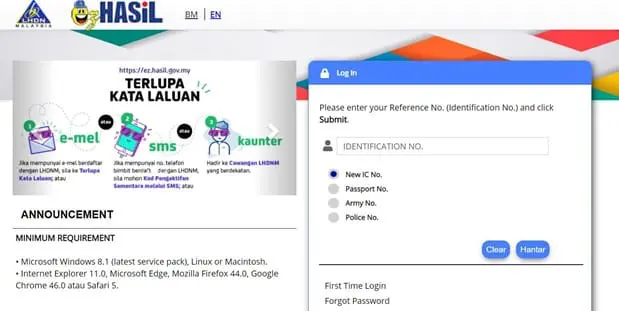
You can access e-Filing through ezHASiL or your tax dashboard, MyTax. Once you’ve logged into e-Filing for the first time and set up your account as per the steps above, you can start filling up your ITRF online. Remember that you can choose to view the e-Filing webpage, your ITRF – and in fact – the entire LHDN website in either English or Bahasa Malaysia; just select the language of your choice at the top of the screen.
3) Filling up your ITRF
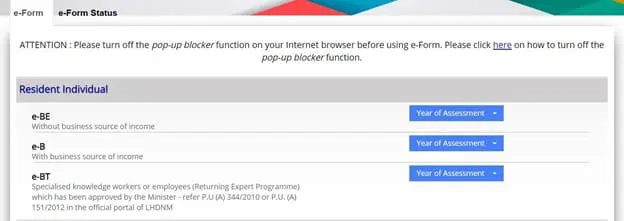
Choose the right type of ITRF based on the category of income that you fall under:
| Income tax return form (ITRF) | Category |
| e-B/e-BT | For residents earning income from business/knowledge or expert worker |
| e-BE | For residents earning income without a business |
| e-M/e-MT | For non-resident individuals/knowledge workers |
As you choose the right form, make sure that you also select the right year of assessment: YA 2021 (remember, you are declaring your income earned for the previous year). Next, we can get right down to the business of filling out your form; here’s a breakdown of what the BE form (for residents earning income without a business) will look like:
i) Particulars of individual
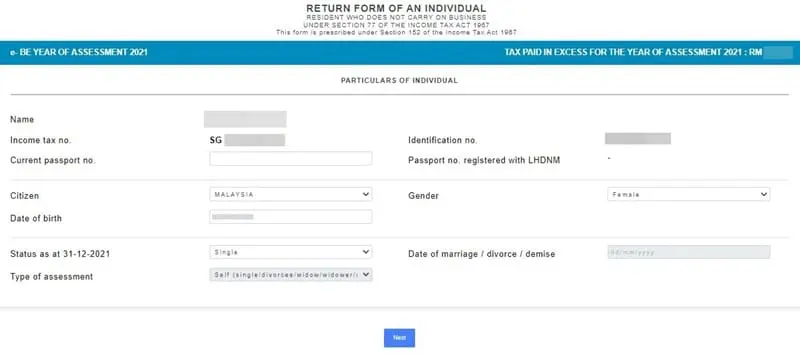
This section requires you to fill in your basic personal details. Some of the items will already have been filled out for you based on the information that you provide when registering as a first-time taxpayer, but always make sure to double check for accuracy. You should also make sure that you select the right type of assessment, which determines whether you will be filing as a single person, or filing together or separately with your spouse.
Just to note, the government had previously said that it will be implementing a new prefix for taxpayers, changing the existing SG (which is the prefix dedicated to individuals with non-business income source) and OG (for individuals with business income source) to IG. However, this has been postponed to an indefinite date.
ii) Other particulars

This is a continuation of the previous section that relates to your individual particulars. Make sure to get your handphone number down correctly as LHDN will send you a TAC when you sign and submit your e-form, and your bank account number must also be accurate if you want to get your tax refund. Additionally, you now have the option to choose DuitNow as your preferred payment method for tax refunds; just be sure to select “Payment via DuitNow” under “Method of payment for tax refund”, and then fill in the required DuitNow information.
If you’ve changed employers in the previous year, make sure to change the Employer’s Number to reflect this update. You’ll also see a new detail that requires you to clarify if there is tax borne by employer; choose “yes” if your income tax is paid by your employer, and “no” if otherwise.
Besides that, the disposal of asset under the Real Property Gains Tax Act 1976 will be relevant to you if you sold any property in the last year.
You will also find the section for Incentive Claims under paragraph 127(3)(b) and subsection 127(3A) here, which relate to specific exemptions made under gazette orders and exemptions given by the Minister of Finance, respectively. You can leave this section blank if this does not relate to you.
iii) Declare your income
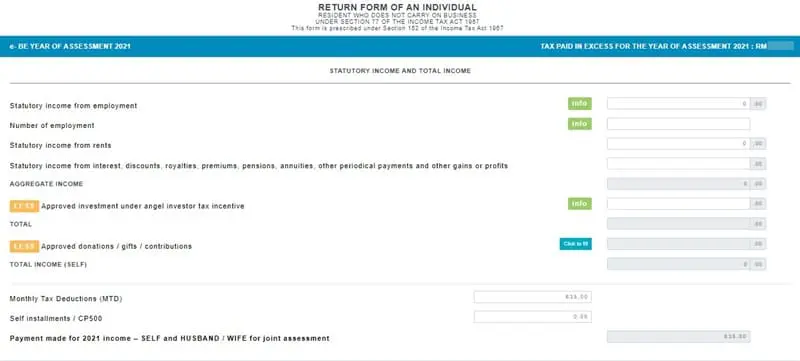
Under statutory income, fill out all the money that you’ve earned from employment, rents, and other source in the respective boxes. This is where your EA form comes into play as it states your annual income earned from your employer.
However, there are several reasons why you shouldn’t merely accept the annual income stated on your EA form as the final figure for your statutory income from employment. You are also required to declare any non-salary related benefits that can count as “income from employment” and may need to be added to your income figure. These include income from rents, interest, discounts, royalties, premiums, pensions, annuities, periodical payments, as well as payments received for part-time and occasional jobs (broadcasting, lecturing, writing, and so on).
Aside from that, you wouldn’t want to include any income that is entitled to tax exemptions on your form either. For instance, perquisites (which cover things like parking, medical, and transport allowances) and benefits-in-kind (such as cars, personal drivers, accommodation, and so on) are taxable under law, but the government has provided some tax exemptions for them. Your severance package may also exempted from tax under certain conditions, if you lost your job in the previous year. If you want to find the answer to whether or not your RM100 monthly travel allowance is tax exempt, check out our article on tax exemptions.
Once you’ve keyed in all your statutory income, the form will automatically total it up to show your aggregate income. The next step will be to move on to any tax deductions you may be eligible for so you can lessen your aggregate income. For example, you can make a tax deduction from your aggregate income if you have made a contribution of gifts or donations to the government or a government-approved charitable organisation. After making the deductions, you will be left with your total income.
At the bottom of this section, you’ll have to key in the total monthly tax deductions (MTD) paid during your year of assessment. MTD or Potongan Cukai Bulanan (PCB) is the compulsory mechanism where employers deduct monthly tax payments from a taxable employee’s salary. You can find this amount on your EA form.
You will also find a section on non-employment income of preceding years not declared, approved investment under angle investor tax incentive, and self-instalments – which you can fill out if relevant.
iv) Claim for tax reliefs and tax rebates
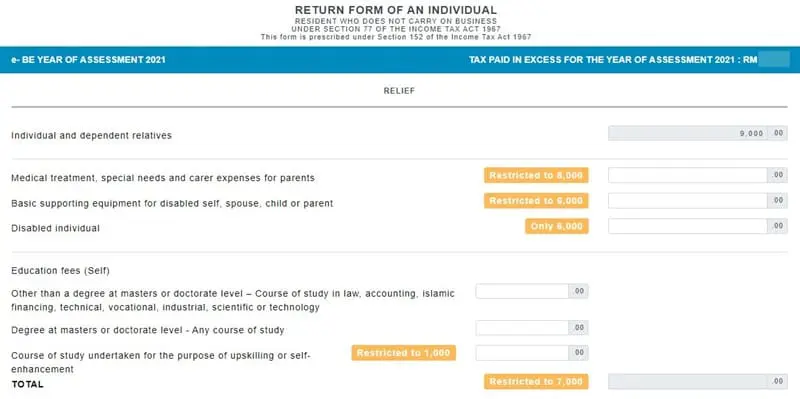
Here comes one of the most important parts of filing your taxes – claiming for tax reliefs and rebates! We’ve already explained how tax relief can reduce your chargeable income (and thus your tax rate and tax amount) above. For the full list of tax reliefs you can claim for in YA 2021 and an explanation of each relief, you can refer to our post on everything you should be claiming for here – or to the infographic below:
Once all your tax reliefs have been claimed, your chargeable income determined, and your tax rate and amount decided, you can claim for any tax rebates you are eligible for. Zakat and fitrah can be claimed as a tax rebate for the actual amount expended up until the total tax amount.
For example, let’s say your employment income is RM50,000 a year and you have claimed RM15,000 in tax reliefs. This would bring your chargeable income down to RM35,000 and the amount of tax you must pay is RM600. If you have contributed RM400 in the last year on zakat, you can minus that amount from the RM600 and end up with a final tax amount of RM200 to pay.
Besides zakat and fitrah, you are also eligible for a tax rebate of RM400 for yourself if your chargeable income does not exceed RM35,000. To find out more about the tax rebates that you could be eligible for, you should also check our article on it here.
v) Check your summary
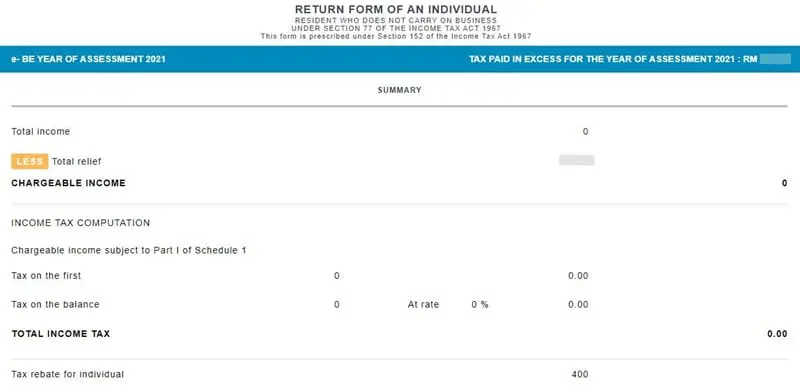
You’re almost done! On this page, you should see the final tax amount displayed. Don’t worry if your tax amount is in the negative as this is due to what you have already paid through MTD. This means you will get a tax refund from the government.
You can always go back through the form at this stage and amend any details that you may have missed out on; the form will make the necessary changes to the final tax amount automatically as you do so. Once you’re certain your form is free from errors, click “Next”.
On the declaration page, request a TAC from the number you’ve registered with LHDN and key it in. Then, click the sign and submit button, and enter your identification number and password in the pop-up (remember to allow pop-ups on your browser for this!), and press the sign button.
And with that, congratulations, you’re done with income tax filing for YA 2021! Before you say goodbye to income taxes for the rest of the year, make sure to save and print the acknowledgement and e-BE form for records purposes.
Amending Your Income Tax Form

If you’ve been extremely careful during the process of filling in your ITRF, then there should not be any mistakes in your form. However, if you eventually catch an error and find yourself needing to amend your income tax declaration – no need to panic! You can submit an appeal for amendments on or before 30 April 2022.
Here are the steps that you will need to take:
- Print your e-form and make corrections in the wrong space (a brief signature next to the correction). Next, make the tax calculation manually up to the “Tax Paid” level. In the event of any balance due, the balance shall be paid on/before 30 April 2022.
- Attach a letter of appeal that explains the changes you wish to make along with a copy of your e-form and all original documents and receipts to confirm income, all claims and tax deductions. Once you’ve done that, you will need to send it to the branch that you have registered with.
- You can also submit your appeal letter and supporting documentation through the IRBM Customer Feedback Portal, if it is more convenient.
- Do note that LHDN will go through each error appeal as part of the audit process and the time taken for the amendment will depend on the information and documents submitted.
Note that you can actually also make online amendments via e-Filing (e-application for amended BE form), but only for the following two specific circumstances – and if your BE form is submitted before the submission deadline:
- Under declared/not declared income
- Overclaimed expense
To access this service, simply go to your MyTax dashboard, click on “e-Filing”, and you’ll find “e-Application for Amended BE” as one of your options. Fill in the form and submit it.

Meanwhile, if you need to amend your ITRF after 30 April, you are allowed to submit an Amended Return Form (ARF) within six months from the ITRF submission deadline. Your ARF must be submitted to the branch that handles your income tax file, and only taxpayers who have submitted their ITRF on time the first round is allowed to submit an ARF. Again, this amendment method is only permitted for the following mistakes:
- Under declared/not declared income
- Overclaimed expenses
- Overclaimed capital allowances, incentives, or reliefs
How To Pay Income Taxes In Malaysia?

With your taxes filed and your final tax amount determined, you will find yourself in either one of two situations.
For those subject to MTD, you may find that tax reliefs and rebates have contributed to making your final tax amount less than what was deducted each month. Therefore, you are eligible for a tax refund! It will be automatically credited to the bank account that you’ve provided in your tax form within 30 working days after submission.
On the other hand, if you find after the filing that you still owe more taxes, you’ll have to pay them before the due date, which is 30 April 2022. Here are a few of the ways you can pay your income taxes in Malaysia:
| Method | Details |
| Online banking through FPX | Requires a bank account with Affin Bank, Alliance Bank, AmBank, Bank Islam, Bank Muamalat, Bank Rakyat, Bank Simpanan Nasional, BNP Paribas Bank, CIMB Bank, Deutsche Bank, Hong Leong Bank, HSBC Bank, Kuwait Finance House Malaysia, Maybank, OCBC Bank, Public Bank, RHB Bank, Standard Chartered Bank, or UOB Bank |
| Online using credit card on ByrHASiL | Visa, Mastercard, American Express accepted |
| Pos Malaysia | Over the counter (cash only) or online |
| Via ATM | Only at CIMB Bank, Maybank, Public Bank, and RHB Bank |
| Via cash deposit machines | Only at Maybank |
While it may be a positive thing to be able to pay your taxes with your credit card, do note that almost all banks do not provide benefits for government-related spending. Therefore, it is unlikely that you will be able to earn cashback or rewards points on the amount that you pay for your taxes. However, some cards do include government spend as part of your monthly or annual spend requirements that go towards unlocking higher cashback tiers or annual fee waivers.
What If You’re Late With Your Income Tax Payment?

A penalty of 10% will be imposed on the balance of tax unpaid after the deadline. A further penalty of 5% will be imposed on the amount owed if the tax and penalty is not paid within 60 days.
If you disagree with the late payment penalty, you can forward an appeal in writing to the Collection Unit of LHDN within 30 days of being issued a Notice of Increased Assessment. However, the penalty imposed has to be settled first regardless of any appeal – if you are successful, LHDN will refund you the relevant amount at a later date.
Appealing Your Income Tax Notice Of Asessment
After you file your taxes, there is a possibility that LHDN may serve you a notice of assessment. A notice of assessment is essentially a written statement by LHDN that states your taxable income, amount of tax due, and so on.
If you disagree with any of the info laid out – perhaps because of a discrepancy in tax reliefs or other errors – you can file an income tax appeal. The appeal must be made within 30 days from the date of notice in writing to the LHDN branch which issued the assessment.
You’re required to fill in the Q form, write a letter identifying the mistakes, and submit supporting documents for any expenses, deductions, or reliefs claimed. The appeal will be forwarded to the Special Commissioners of Income Tax. Should you have a valid reason for requiring more than 30 days to file an appeal, then the N form is the one you’ll need. Both the Q and N forms are available at the LHDN office, or can be downloaded from the LHDN website here.
When Do I Stop Filing My Taxes?

Malaysians are allowed to stop paying taxes only when they have permanently closed their tax files, which is permitted under any of the following three conditions:
- A retiree with no taxable income
- An individual who is leaving Malaysia for good
- An individual aged 55 years and above, with no taxable income
So for instance, let’s say you are a retiree who is still taking up some freelance jobs every now and then (with earnings not exceeding RM34,000 per annum), or an individual aged 45 with no taxable income. In both circumstances, you’re still required to continue filing your taxes as you do not meet the criteria required to close your tax files.
Remember, filing your taxes does not necessarily translate to having to pay taxes; you only pay taxes if your chargeable income requires you to. Filing your taxes, meanwhile, is a matter of accountability where you declare what you have earned in the previous year.
Finally, if you’re eligible to close your tax files permanently and you’d like to do so, you’ll need to send an official notification or letter to the branch where your tax file is handled. You must also ensure that there is no outstanding amount that needs to be paid, or a pending refund status before submitting your income tax file closure application.
***
We hope that this guide will be useful to you as you file your taxes this year. We also have a whole series of articles that address different aspects and questions pertinent to income tax filing; you can access them from the list below:
- Everything You Should Claim As Income Tax Relief Malaysia 2022 (YA 2021)
- Income Tax Malaysia: What’s New For YA 2021?
- How To File Your Taxes For The First Time
- How To Check If Your Hotel Stay Is Eligible For The Tourism Tax Relief
- Confirmed: Special Lifestyle Tax Relief Is Stackable For Smartphone, Personal Computer, & Tablet Purchases
- MyTax: One-Stop Portal To Make Tax Filing More Convenient
- How To Claim Income Tax Reliefs For Your Insurance Premiums
- Income Tax Malaysia: Quick Guide To Tax Deductions For Donations And Gifts
- Understanding Income Tax Reliefs, Rebates, Deductions, And Exemptions In Malaysia
- How To File Your Taxes As A Freelancer
- How To File Income Tax For Your Side Business
- How To File Your Taxes If You Changed Or Lost Your Job Last Year
- How To Pay Income Tax In Malaysia
- Income Tax Glossary
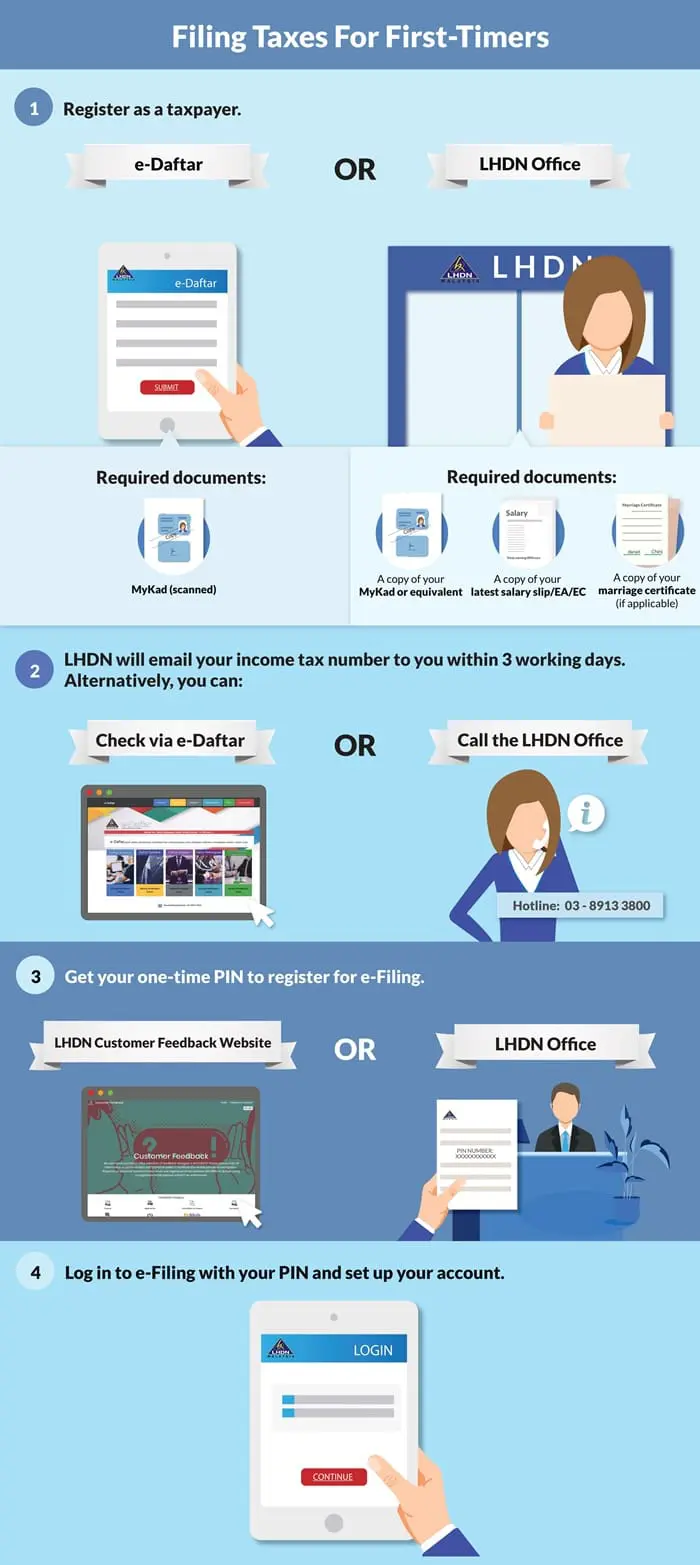


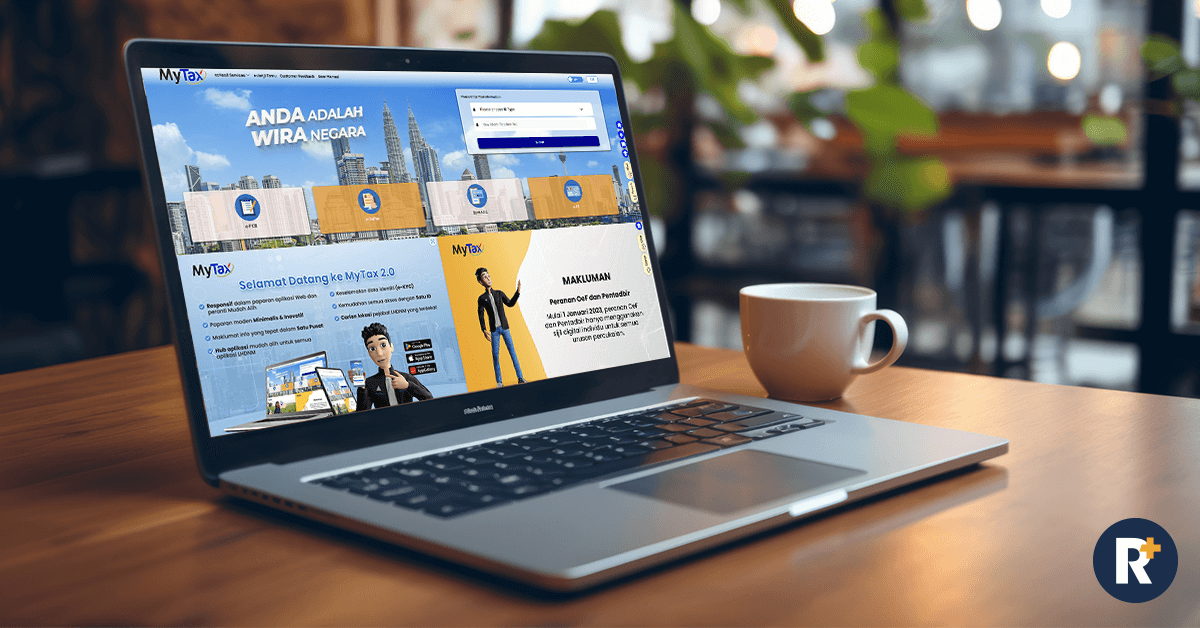
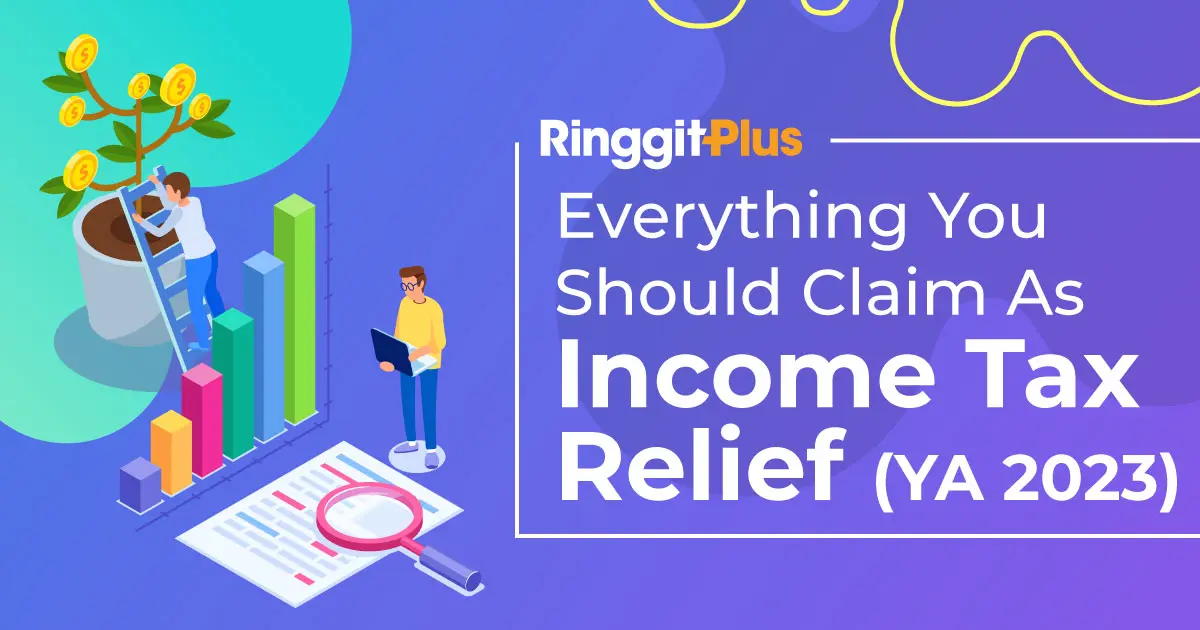





Comments (4)
Hi Alex
Acute skin allergy is consider serious disease? Medical expenses deductible?
Hi Ms Cheong, just a question, last year I bought a iphone for my son under maxis as he is my subline, and I pay monthly for it, can I make a claim on it, thank you
Hi Alex, may I know whether walk in fees to gym is claimable ? Is it claimable under Lifestyle – Additional relief for the use / benefit of self, spouse or child in respect ?
Hi Alex
eye surgery (cataract) is it claimable under medical expenses?